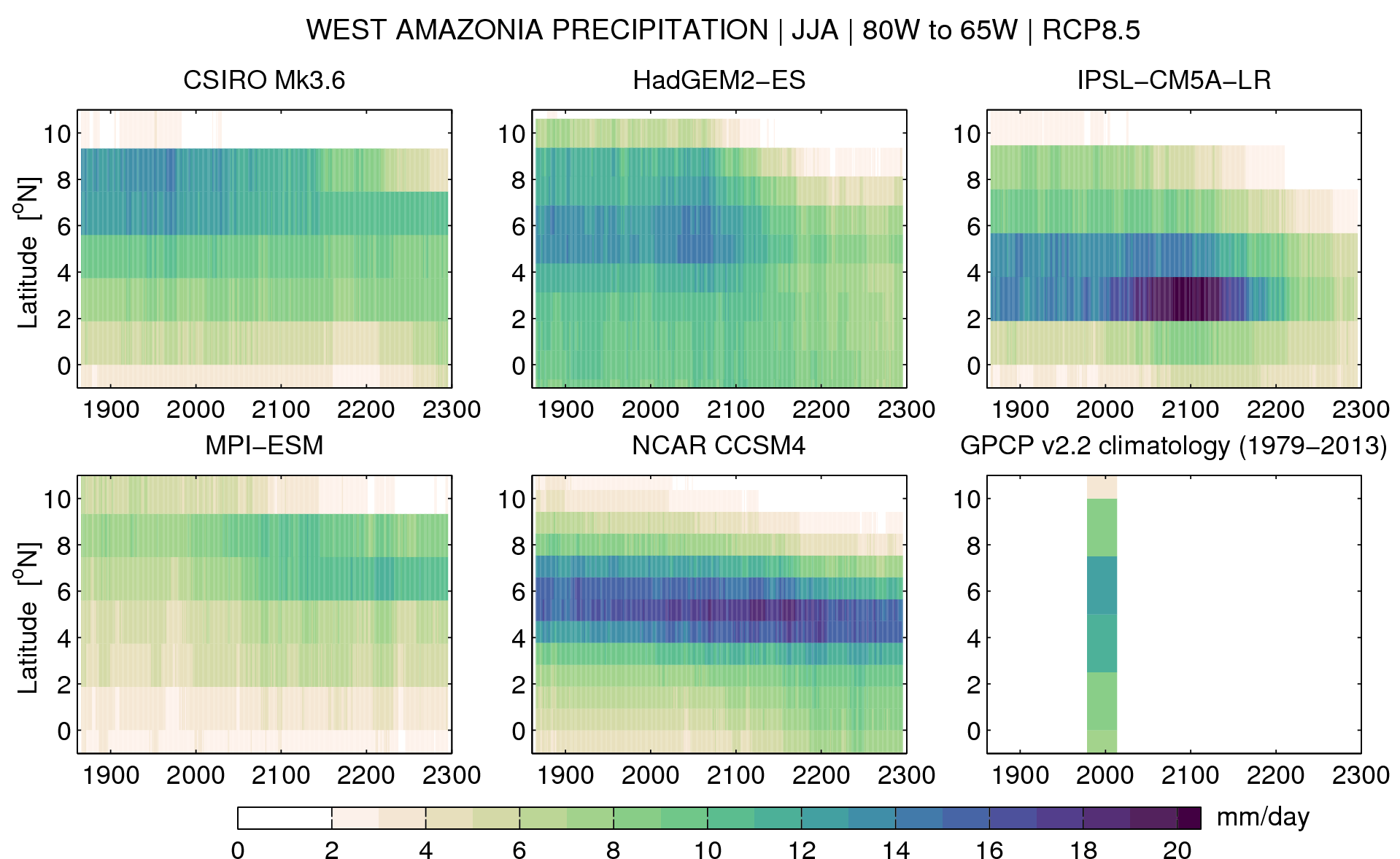A prevailing paradigm of how rainfall patterns will change on a warming Earth is that the hydrological cycle strengthens causing wet regions to get wetter and dry regions to get drier.
However, this is not always the case: Hawkins, Joshi & Frame (2014) highlight one particular effect – the movement of the Inter-Tropical Convergence Zone (ITCZ) – as a key long-term driver of rainfall changes that do not follow this ‘wet get wetter’ paradigm.
[Update 30/07/14: Two comments below rightly point out that the ‘wet get wetter’ paradigm is understood to be an oversimplification of what is expected, especially over land regions.]
The ITCZ is a band of clouds & rain found near the equator. It moves north & south during the seasons, following the Sun’s zenith, but is also projected to move more permanently as the planet warms.
Our key new finding is that, if you warm the planet for long enough, this ITCZ band will move over some regions (making them wetter) and eventually past them (making them drier again). This is like a very slow moving weather front.
Figure 1 below shows projected summer precipitation in five GCMs from 1860-2300 using historical & RCP8.5 emissions for a region in South America (80W-65W), compared with a climatological estimate from GPCP.
Some GCMs (especially those with higher spatial resolution) demonstrate this ‘wetter then drier’ signal for this particular region as the ITCZ slowly moves southwards. However, there is considerable model uncertainty in the projected response as other GCMs do not show this effect. Note also that just using an ensemble mean would likely not reveal this signal.
Figure 2 shows the precipitation timeseries for 5°N highlighting the ‘wetter then drier’ effect for a single location. The projected rainfall changes are seen to be ‘non-monotonic’, with implications for planning for a changing climate, i.e. should decisions be made assuming a wetter or drier future? Projected temperatures continue to increase in this region in all cases.
Finally, we note that economic models of climate change assume quite simple and constant relationships between rainfall and temperature. This research demonstrates the limits of these assumptions.


Hawkins, E., Joshi, M., & Frame, D. (2014). Wetter then drier in some tropical areas Nature Climate Change, 4 (8), 646-647 DOI: 10.1038/nclimate2299
Here’s the relevant para from Chapter 12 IPCC AR5
To analyze the patterns of projected precipitation changes, a useful
framework consists in decomposing them into a part that is related to
atmospheric circulation changes and a part that is related mostly to
water vapour changes, referred to as dynamical and thermodynamical
components, respectively. However, the definition of these two components
may differ among studies. At the time of the AR4, the robust
changes of the difference between precipitation and evaporation
(P – E) were interpreted as a wet-get-wetter and dry-get-drier type
of response (Mitchell et al., 1987; Chou and Neelin, 2004; Held and
Soden, 2006). The theoretical background, which is more relevant over
oceans than over land, is that the lower-tropospheric water vapour
increase with temperature enhances the moisture transported by
the circulation. This leads to additional moisture convergence within
the convergence zones and to additional moisture divergence in the
descent zones, increasing the contrast in precipitation minus evaporation
values between moisture convergence and divergence regions.
A weakening of the tropical overturning circulation (see Section
12.4.4.2) partially opposes this thermodynamic response (Chou and
Neelin, 2004; Held and Soden, 2006; Vecchi and Soden, 2007; Chou
et al., 2009; Seager et al., 2010; Allan, 2012; Bony et al., 2013). At the
regional scale the dynamic response may be larger than the thermodynamic
response, and this has been analyzed in more detail since
the AR4 (Chou et al., 2009; Seager et al., 2010; Xie et al., 2010; Muller
and O’Gorman, 2011; Chadwick et al., 2012; Scheff and Frierson, 2012;
Bony et al., 2013; Ma and Xie, 2013). Over continents, this simple wet get-
wetter and dry-get-drier type of response fails for some important
regions such as the Amazon. At the global scale, the net water vapour
transport from oceans to land increases, and therefore the average P –
E over continents also increases (Liepert and Previdi, 2012).
Sun et al. looked at global precip over the last 70 years (1940-2009) and unexpectedly found a decrease in variance where, on average, “the dry became wetter while wet became drier.”
Changes in the variability of global land precipitation
http://onlinelibrary.wiley.com/doi/10.1029/2012GL053369/abstract
During the holocene climate optimum, which was several degrees warmer than now, The Sahara had rivers and lakes, China had forests and woodland where there is now savanah, warmer is wetter overall